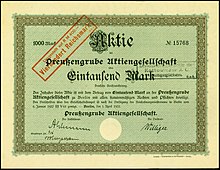Kopalnia Węgla Kamiennego Miechowice
The coal mine Miechowice (Polish: Kopalnia Węgla Kamiennego Miechowice ; old German name Preußengrube ) is a disused coal mine in the Miechowice district of Bytom , Poland.
history
Prussia Mine
The Miechowitz coal mines were founded on November 16, 1863 through the consolidation of five mine fields that had been awarded to Franz Hubert von Tiele-Winckler between 1858 and 1861. In 1860 the "Achtung" mine field was added, so that a total size of 9.51 km² was achieved. The mine itself was founded from the two parts "Miechowitzer Steinkohlengruben" and "Steinkohlenbergwerk Preußen" on October 10, 1900.
The sinking of the "Jelka" (later designation MI) and "Winckler" (M-II) shafts as well as the construction of the daytime facilities began in the same year and the first coal could be mined two years later. The colliery mined several seams in the northern rim of the Upper Silesian coal basin, which had a total thickness of 34 meters. Between 1906 and 1910 the “West Shaft” was added as a weather shaft, in 1911 the “South Shaft”, and from 1928 to 1930 the “North Shaft” was sunk.
The colliery, which in the meantime repeatedly bore the name Preußengrube , belonged to Preußengrube AG when it was founded and from 1914 to Kattowitzer AG for mining and ironworks (the main shareholder was Tiele-Winckler). In autumn 1921, after Friedrich Flick had bought all the shares in Kattowitzer AG from Tiele-Winckler, the Preußengrube was spun off from the KAG, briefly managed as an independent AG based in Berlin, only to be taken over by Obereisen in 1922.
During the National Socialist occupation of Poland , the mine was operated by the Reichswerke Hermann Göring (1st group of the Upper Silesian Mining Administration of the HGW; together with Knurow and the Oehringengrube )
In 1938, the above-mentioned shafts had the following depths and functions: "Jelka" conveyor shafts 735 m (double conveyance; cable journey; moving weather shaft) and "Winckler" 544 m (cable journey; moving weather shaft); Weather and cableway shafts "North" 551 m (extending) and "West" 408 m (extending).
CHP Miechowice
In addition to the pre-war and wartime extraction and weather shafts of the mine now called Miechowice , the last shaft “Ignacy” was added between 1959 and 1965, which still serves as a weather shaft for the Bobrek mine today .
In 1993, six miners were killed in a mountain strike.
As part of restructuring measures in 1997, the mine was merged with the Bobrek mine under the name Bobrek-Miechowice (Bytom Division III).
This association was dissolved again in 1999, the Miechowice plant was shut down and in 2005 all headframes and daytime systems were dismantled. The area has been unprotected since then, so accidents occur again and again, mainly due to metal theft.
Funding figures
- 1913: 750,017 tons
- 1938: 1.59 million tons
- 1970: 1.95 million t
- 1979: 2.49 million t
swell
- Jerzy Jaros: Słownik historyczny kopalń węgla na ziemiach polskich . Katowice 1984.
- Yearbook for the Upper Mining District Wroclaw . Phönix-Verlag, Kattowitz / Breslau / Berlin 1913, digitized version at http://www.dbc.wroc.pl/dlibra/publication?id=3349&tab=3 (last accessed on May 5, 2015).
- Prussian Mining Authority in Breslau (ed.): The Silesian Mines 1938 . Publishing house NS-Druckerei, Breslau.
- Kurt König: The coal mining in Upper Silesia from 1945–1955 . Scientific contributions to the history and regional studies of Eastern Central Europe. Published by the Johann Gottfried Herder Institute. Marburg 1958.
- Paul Deutsch: The Upper Silesian coal and steel industry before and after the division of the industrial area . Bonn 1926.
Web links
- Numerous pictures and additional information about the mine can be found at http://eksploratorzy.com.pl/viewtopic.php?f=21&t=4211&start=20 (last accessed on January 4, 2016)
- At http://igrek.amzp.pl/mapindex.php?cat=FLOTZKARTOS there are 43 flötz maps (sic) of the Upper Silesian hard coal basin as JPG files showing field boundaries, seams and shafts as per the 1902 inventory. Published by "Verlag von Priebatsch's Buchhandlung, Breslau" (accessed on January 3, 2016)
Coordinates: 50 ° 21 ′ 7.2 " N , 18 ° 50 ′ 10.7" E
